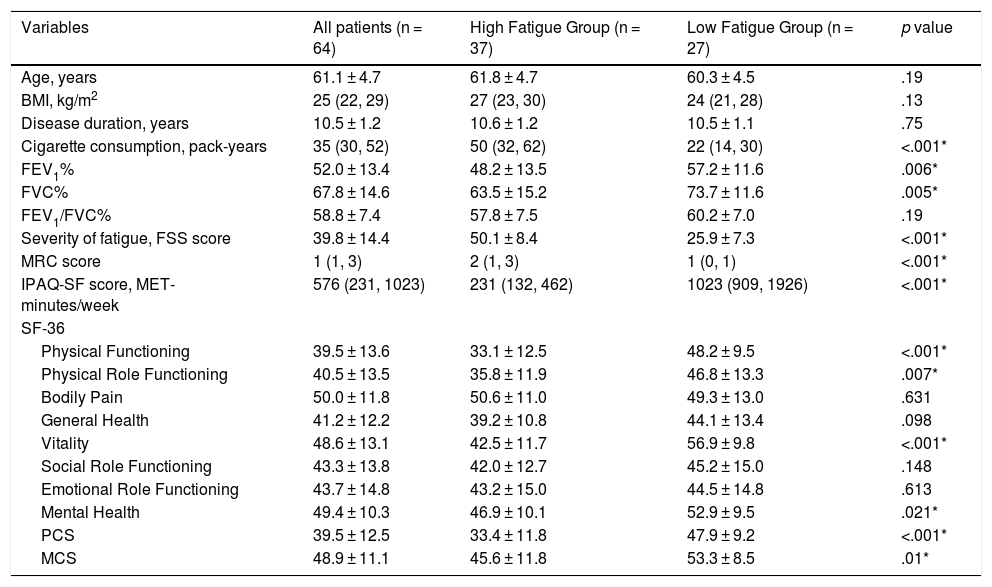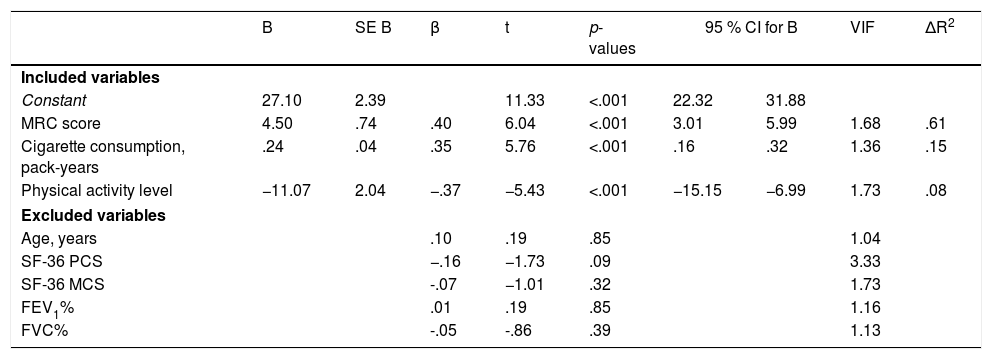Fatigue, the second most common symptom after dyspnea in patients with chronic obstructive pulmonary disease, impairs functional capacity and quality of life. This study aims to predict the factors that affect fatigue severity and investigate the effects of fatigue in patients with chronic obstructive pulmonary disease.
MethodsData were collected to assess demographic and clinical characteristics, cigarette consumption, fatigue severity (Fatigue Severity Scale), dyspnea severity (Medical Research Council Dyspnea Scale), level of physical activity (International Physical Activity Questionnaire Short-Form), and health-related quality of life (36-Item Short Form Health Survey).
ResultsA total of 64 male COPD patients were evaluated (mean age 61.1 ± 4.7 years, mean FSS score 39.8 ± 14.4). The result of the linear regression model was significant and explained 84% of the variance in fatigue severity (Adjusted R-squared = 0.84, F = 29.48, df = 60, p < .001). It showed that the MRC score (β = .40), cigarette consumption (β = .35), and physical activity level (β = −.37) were significantly correlated with the severity of fatigue (p < .001 for all) and that they independently contributed to the prediction of severity of fatigue.
ConclusionDyspnea, cigarette consumption, and physical activity level affect fatigue severity. Additionally, physical activity level, pulmonary function, and HRQOL were also associated with fatigue. These findings support the assertion that it is important to measure fatigue and the factors that affect its severity.
La fatiga, el segundo síntoma más común tras la disnea en pacientes con enfermedad pulmonar obstructiva crónica, afecta a la capacidad funcional y a la calidad de vida de quienes la padecen. El objetivo de este estudio es predecir los factores que afectan a la gravedad de la fatiga e investigar los efectos de la fatiga en pacientes con enfermedad pulmonar obstructiva crónica.
MétodosSe recogieron datos para evaluar las características demográficas y clínicas, el consumo de tabaco, la gravedad de la fatiga (escala de gravedad de la fatiga), la gravedad de la disnea (escala Medical Research Council Dyspnea), el nivel de actividad física (Cuestionario Internacional de Actividad Física versión corta) y la calidad de vida relacionada con la salud (Cuestionario de Salud SF-36).
ResultadosSe evaluaron un total de 64 pacientes de EPOC varones (media de edad 61,1 ± 4,7 años, puntuación media de la FSS 39,8 ± 14,4). El modelo de regresión lineal fue significativo y explicaba el 84% de la varianza de gravedad de la fatiga (R cuadrado ajustado = 0,84; F = 29,48; df = 60; p < 0,001). Los resultados pusieron de manifiesto que la escala MRC (β = 0,40), el consumo de tabaco (β = 0,35) y el nivel de actividad física (β = −0,37) estaban significativamente correlacionadas con la gravedad de la fatiga (p < 0,001 para todos), y que contribuían de manera independiente en la predicción de la gravedad de la fatiga.
ConclusiónLa disnea, el consumo de tabaco y el nivel de actividad física afectan a la gravedad de la fatiga. Además, el nivel de actividad física, las funciones pulmonares y la CVRS estaban asociados con la fatiga. Estos hallazgos nos demuestran que es importante identificar la fatiga y los factores que influyen en su gravedad.
Article
Diríjase desde aquí a la web de la >>>FESEMI<<< e inicie sesión mediante el formulario que se encuentra en la barra superior, pulsando sobre el candado.

Una vez autentificado, en la misma web de FESEMI, en el menú superior, elija la opción deseada.

>>>FESEMI<<<







